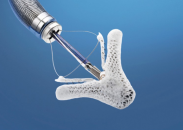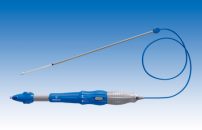This statement is based on eye exams conducted during the last SCAI meeting (Society for Cardiovascular Angiography and Interventions), where 47% of evaluated operators had radiation related lesions in their crystalline. In time, these might turn into cataract. Studies on astronauts and Chernobyl survivors have shown a clear association between ionizing radiation and crystalline damage,…
[SURTAVI] Sub-study of neurological events: more evidence in favor of TAVR
Courtesy of SBHCI. The occurrence of a periprocedural neurological events is associated to an increased risk of death and morbidity at long term, both for transcatheter aortic valve replacement (TAVR) and for surgery. The SURTAVI study, recently presented at the ACC meeting and simultaneously published by NEJM, showed that TAVR with self-expandable CoreValve or Evolut…
NOTION: TAVI with low risk at 4 year follow up
Courtesy of the SBHCI. There is little data about the use of transcatheter aortic valve replacement (TAVR) to treat patients with severe aortic stenosis at low surgical risk. Many of the questions involve long term duration of valves (over 10 years) when treating younger patients with longer life expectancy. The NOTION study aims at comparing…
VIVA Post-Market Study: More Evidence for the Valve-in-Valve Technique
Courtesy of the SBHCI. Bioprosthetic surgically-implanted valves degenerate over time, while patients become too old and are at high risk for reoperation. Transcatheter aortic valve implantation inside a deteriorated surgically-implanted valve (a valve-in-valve procedure) is an emerging alternative. The VIVA trial was designed to offer systematic and prospective data from patients treated with…
Mitral Valve Global Registry: transcatheter mitral valve replacement due to native valve disease
Courtesy of the SBHCI. The risk of surgical mitral valve replacement in patients with significant annular calcification is very high. There are isolated reports of transcatheter mitral valve replacement with balloon-expandable valve in this patient population. In consequence, this multicenter registry tries to concentrate information and analyzes the outcomes a year after the procedure. …
Cerebral protection during TAVI still offers weak evidence, but there is hope
Silent ischemic embolic lesions are common after transcatheter aortic valve implantation (TAVI). The use of cerebral protection devices might reduce the occurrence of these embolic lesions. Multiple studies with different devices, designs, and outcomes challenge the usefulness of cerebral protection during TAVI. A comprehensive analysis of the literature was necessary to obtain a more…
Moderate Aortic Stenosis and Ventricular Dysfunction: Should Valve Replacement Come Sooner?
Ventricular dysfunction and moderate aortic stenosis are more frequent with advancing age and often coexist. Afterload reduction is one of the main pillars of pharmacological treatment of heart failure, and aortic stenosis (even that of moderate severity) increases the afterload. Nowadays, aortic valve replacement is only formally indicated for symptomatic severe aortic stenosis. This…
CENTERA: Results of the New Self-Expandable Valve
This new device offers the advantage of a lower frame height, which reduces the chance of coronary occlusion. The delivery system is totally motorized and the valve can be repositioned. In addition, the sheath is “14 F” for all valve sizes (23, 26 and 29mm). 203 patients were included, all with severe aortic stenosis…
ARTE: Aspirin or Aspirin and Clopidogrel after TAVR?
Courtesy of SBHCI. This study presented at Euro PCR and simultaneously published by JACC Cardiovascular Interventions poses a question that has remained unanswered since the start of TAVR. There is little information on the optimal antithrombotic therapy after transcatheter aortic valve replacement (TAVR). In general, patients receive between 1 and 6 months of dual…
Bad prognosis for post-MitraClip mitral valve stenosis: how do we proceed?
Courtesy of Dr. Carlos Fava The EVEREST II trial showed the MitraClip had similar mortality rate to that of surgery but, even though residual mitral valve regurgitation (MR) is associated to a strong negative impact, little is known about post MitraClip increased transvalvular gradient and its implication. 268 patients undergoing MC implantation were analyzed.…
REPRISE III: Lotus and CoreValve Compared in High-Risk or Inoperable Patients
The efficacy of transcatheter aortic valve replacement (TAVR) has been well-established. However, its limitations include suboptimal deployment and paravalvular leak. The Lotus system is a fully repositionable and retrievable device with controlled mechanical expansion. It features an adaptive seal to minimize paravalvular leak, it does not require early pacing during deployment, and, given its early…










